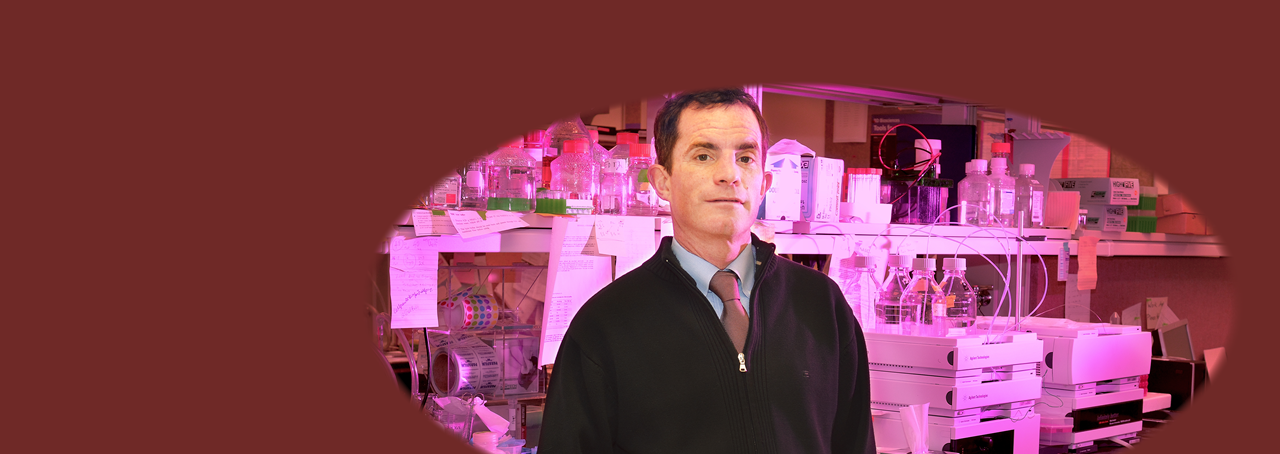With a single molecule, an opportunity to help millions of people
The implications of William G. Kerr’s research are so enormous, he keeps reminding himself it isn’t all a dream.
Five years ago, he discovered a way to temporarily inhibit an enzyme called SHIP1, which could potentially help millions of people with cancer, HIV/AIDS, and leukemia regrow their blood cells after chemotherapy, radiation, or bone marrow transplants. Next, while investigating that first discovery with the help of graduate student Sonia Iyer, now a post-doc at MIT, he surprised himself with a second: constraining that same SHIP1 could potentially help millions of people suffering from obesity.
“I have to pinch myself sometimes,” says Kerr, the Murphy Family Professor of Children’s Oncology Research, who arrived at SUNY Upstate Medical University in 2009, after nine years as a professor of oncology at the University of South Florida. “When we started out, based on the genetics work we’d done, it seemed as though we had a reasonable hypothesis. I still can’t believe it’s working as well as it is, but that’s how research goes. I’ve had a lot of failures in my career, so it’s nice to have a few victories to balance things.”
Working with John Chisholm, an associate professor of chemistry at Syracuse University, graduate students in Chisholm’s lab, and students and post-docs in his own lab, Kerr has successfully developed dozens of molecules that can target SHIP1 in mice and human cells.
From multiple studies, including recent work by grad student Robert Brooks, they’ve shown that using a number of these molecules significantly increases the number of blood-producing stem cells in mice that have undergone radiation treatment. Brooks and Kerr also found that mesenchymal stem cells, which make bones and cartilage, are also increased by treatment with these molecules.
With the second, more unexpected result, they’ve given the molecules to mice on a high-fat, obesity-inducing diet. But instead of gaining weight, or showing signs of developing obesity, the mice have actually lost weight, lost body fat, and gained lean body mass – all seemingly without any adverse side effects to appetite or health.
Now, using a 2015 investment from SUNY’s Technology Accelerator Fund (TAF), Kerr is returning to his library to systematically retest the inhibitory properties of each molecule in a high-throughput analysis. He will also test new compounds they have recently discovered through a computational, drug design approach.
With this project, “Defining the Most Potent SHIP1 Inhibitory Drug Candidates for Blood Cell Recovery and Treating Obesity,” his research group will take six months to determine which molecule, or molecules, in the library holds the greatest potential for pharmaceutical development.
From there, Kerr hopes to expand the study to larger, more complex animal models within the following year, while also exploring the possibility of treating obesity in companion animals, and after that, progress to human clinical trials within five years. There’s still a long way to go, and though the potential impact of this technology is just too large to grasp – there are 1.7 million new cancer cases reported each year in the United States, plus 1.3 million people with HIV/AIDS, .5 million people on dialysis, and 97 million with obesity – Kerr is excited to keep pushing forward.
“That’s the passion we have for science, where there’s always a new challenge coming down the road,” he says. “We’re entering the area researchers call the Valley of Death, where really good ideas, backed by scientific data, fail to become commercialized. It’s a minefield, and even with all the wonderful research we’ve done so far, we don’t know that it’s going to work in humans.
“For a long time, I suspected SHIP inhibitors would be important for promoting stem cell growth, but if anybody had told me five years ago that we’d be making contributions on obesity, I would have laughed at them,” continues Kerr. “That’s just where our research led us. Science has a circuitous, serendipitous path, and that’s part of what makes it fun.”
comments powered by Disqus


